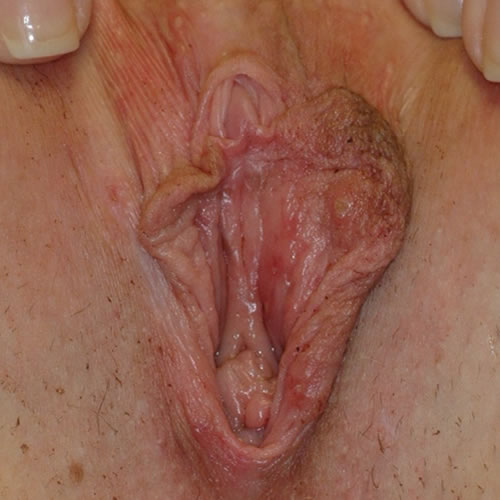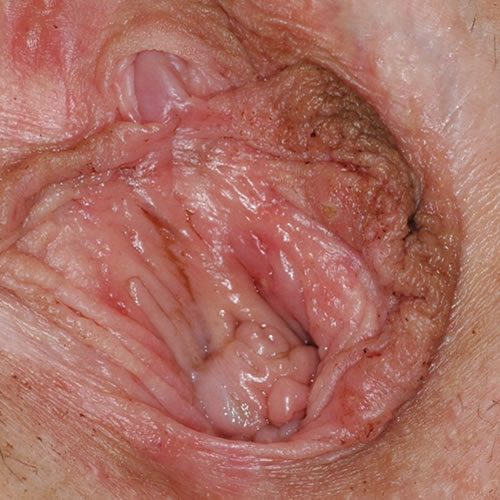Introduction
Water retention and worsening of acne are common cyclical complaints among women and are known to accompany the second half of the menstrual cycle. But for a few, the luteal phase of the menstrual cycle, when endogenous progesterone is at peak levels, is associated with a variety of skin lesions and other allergy-like symptoms. Exogenous use of progesterone in contraceptives and infertility treatments is also associated with these reactions. Urticaria, angioedema, asthma, psoriasis, atopic eczema, irritant dermatitis, erythema multiforme, and even anaphylaxis may occur. Previously known as “autoimmune progesterone dermatitis,” lack of evidence of actual autoimmunity and recognition of sensitization to progestins, has brought current researchers to propose a name change to “progestogen hypersensitivity” (PH). 1 2 Delays in diagnosis of PH are common since both patients and clinicians may miss the association of symptoms with menstrual cycle changes or with the use of exogeneous progestins. Underlying mechanisms in exposure to endogenous progesterone include reduced immune and barrier functions as a result of cyclical fluctuations in estrogen and/or progesterone.3
Epidemiology
This uncommon hypersensitivity condition affects women of reproductive age.4 Onset may start with the menarche or may occur at any time during the pre-menopausal years. Despite the use of post-menopausal hormone treatment that may include a progestin, PH has not been reported in the menopausal age group. Nor has it been reported in transgender hormone therapy patients. The first description of a patient with “autoimmune progesterone dermatitis” was written up in 1921.5 In 2011, 50 cases had been described6 and, by 2016, 200 cases had been reported in the international literature. There are no longitudinal or prospective studies. The longest case series over the course of 10 years included only 24 patients.7 There is concern that, with the increased use of exogenous progestogens in the form of contraceptives or infertility treatments, there will be a concomitant rise in cases of PH.
Etiology
Progestogens include progesterone in any of its forms, natural or synthetic. Progesterone, an endogenous steroid hormone, is essential to the normal menstrual cycle, pregnancy, postpartum, and lactation. Exogenous progesterones in the form of medications that help with contraception, infertility, maintenance of pregnancy, endometriosis, amenorrhea, and menopausal symptoms are called progestins. Progestins are functionally similar to natural progesterone but are structurally different.8 Progestins may differ just enough from natural progesterone to cause immunological hypersensitivity reactions. There is also a question of possible cross-reactivity with other steroid hormones.
Although the following hypersensitivity reactions have been documented, uniform mechanisms that occur in every case have not been identified. The heterogeneity of signs and symptoms indicates probable multifactorial pathogenesis.
Immunologic hypersensitivity mechanisms understood so far have included:
Type I: immediate (within 1 hour) usually related to exogenous progestins. IgE-mediated with activation of mast cells and basophils and release of vasoactive substances leading to anaphylaxis, angioedema, bronchospasm, and/or urticaria.
Type III: immune complex hypersensitivity (taking hours, to days or weeks). Soluble, antigen/antibody complexes (progesterone-specific IgG antibodies), not adequately cleared by innate immune cells are deposited into tissues and cause an inflammatory response.
Type IV: cell-mediated or delayed hypersensitivity (within hours to days). Activation of T-cells by the antigen causes dermatitis, morbilliform (measles-like) or pustular rashes, rarely, exfolliative dermatoses such as Stevens-Johnson Syndrome/Toxic Epidermal Necrolysis (SJS/TEN), or, extremely rarely, DIHS (drug induced hypersensitivity syndrome with eosinophilia and systemic symptoms).9
Symptoms and clinical features
Onset has been reported as early as menarche.10 PH may first appear, improve or worsen with pregnancy and the peripartum period.11 Symptoms correlate with luteal phase levels of progesterone 14 days prior to menses and usually include either epithelial, respiratory, or systemic reactions (asthma or anaphylaxis). Skin eruptions occur 3-10 days prior to the onset of menstrual flow and resolve a few days after onset of the menses, though they may also last throughout the month. When periods are irregular, the diagnosis is particularly difficult and may be missed. Signs and severity can vary from barely detectable to anaphylactic,12 and can vary in presentation from month to month. In a study of 24 women, 42% had reactions to endogenous progesterone, while 58% to exogenous progestins. 13% had asthma symptoms that were either perimenstrual or induced by an exogenous progestogen.13 Women who are using an exogenous progestogen usually have symptoms that will map with taking the medication rather than with their menstrual cycles.
A variety of rashes and reactions has been described. In the study of 24 patients, the most common symptoms were cyclical dermatitis, urticaria, angioedema, asthma, and anaphylaxis. Other presentations include papulovesicles (eczema), annular erythema, stomatitis, folliculitis, Stevens-Johnson syndrome, vesicobullous reactions, dermatitis herpetiformis-like rash, mucosal lesions and oral aphthae.14 Vulvar lesions may resemble any of the skin reactions. Itching is a common complaint.


Diagnosis
Diagnosis is based on clinical history and physical exam along with elimination of other differential diagnoses. Referral to an experienced allergist is very helpful for both diagnosis and treatment.
Diagnostic criteria include:
- observation of cutaneous or systemic symptoms related to the luteal phase of the menstrual cycle or to exposure to exogenous progestogens
- positive immediate response to epicutaneous (skin prick) testing with progesterone in patients with symptoms suggestive of an IgE-mediated reaction that begins a few days before the onset of menses and resolves during or after the completion of menses
- symptomatic improvement after inhibiting progesterone secretion by suppressing ovulation
Evaluation by skin prick (epicutaneous) testing which gives immediate results, or intradermal testing, which may give immediate or delayed results, will support the diagnosis if positive, but a negative result will be inconclusive. Patch testing with progesterone is also advocated by some authors.15 The diluents to the progesterone used in the tests also need to be tested separately but concurrently. Patients who present with symptoms of Stevens-Johnson syndrome, should not have skin testing at all. There are caveats to all of these attempts at diagnosis.
Pathology/laboratory findings
There are no specific histological features on biopsy. Superficial perivascular mixed inflammation is the most consistent finding. Potentially useful progesterone specific IgE immunoassays are being studied but are not yet commercially available.16
Differential diagnosis
Other skin conditions that may be more severe during the perimenstrual period, include herpes simplex (cold sores), lupus erythematosis, atopic dermatis, acne, rosacea, and psoriasis. NSAID hypersensitivity and idiopathic urticaria should be considered.
Treatment/management
Referral to an experienced allergist who will both test (if appropriate) and treat is very important. Treatment will differ depending on the patient’s stage of life and desire for childbearing.
PH is not very responsive to systemic glucocorticoids such as prednisone and antihistamines, but both may be tried (and are sometimes used prior to skin testing, as well).17 18 Inhibition of progesterone secretion by ovulation suppression is a standard approach. Oral contraceptives have had limited success since they all contain a progestin, but in some cases, use of an OCP with a non-fluctuating dose of progesterone, with no menstruation, can be helpful. GnRH agonists and tamoxifen have been used successfully. Early attempts at desensitization were not effective, but recent successes have been achieved; for women requiring in-vitro fertilization, desensitization to progesterone resulted in viable pregnancies.19 20
References
- Foer D, Buchheit KM, Gargiulo AR, Lynch DM, Castells M, Wickner PG. Progestogen Hypersensitivity in 24 Cases: Diagnosis, Management, and Proposed Renaming and Classification. J Allergy Clin Immunol Pract. 2016 Jul-Aug;4(4):723-729. doi: 10.1016/j.jaip.2016.03.003 Epub 2016 Apr 16. PMID: 27090357.
- Foer D, Buchheit KM. Presentation and natural history of progestogen hypersensitivity. Annals of allergy, asthma & immunology: official publication of the American College of Allergy, Asthma, and Immunology vol. 122,2 (2019): 156-159. doi: 10.1016/j.anai.2018.10.023.
- Raghunath RS, VEnables ZC, and Millington GW. The menstrual cycle and the skin. Clin Exp Dermatol. 2015 Mar;40(2):111-15, doi:10.1111/ced.12588 Epub 2015 Feb 11.
- Baptist AP, Baldwin JL. Autoimmune progesterone dermatitis in a patient with endometriosis: case report and review of the literature. Clin Molecular All. 2004; 2(1):10.
- Geber H. IV. Einige Daten zur Pathologie der Urticaria menstruationalis. Dermatologische Zeitschrift. 1921;32:143-150.
- Lee MK, Lee WY, Yong SJ, et al. A case of autoimmune progesterone dermatitis misdiagnosed as allergic contact dermatitis. Allergy Asthma Immunol Res. 2011;3(2):141-144. doi:10.4168/aair.2011.3.2.141.
- Foer D, Buchheit KM, Gargiulo AR, Lynch DM, Castells M, Wickner PG. Progestogen Hypersensitivity in 24 Cases: Diagnosis, Management, and Proposed Renaming and Classification. J Allergy Clin Immunol Pract. 2016 Jul-Aug;4(4):723-729. doi: 10.1016/j.jaip.2016.03.003 Epub 2016 Apr 16. PMID: 27090357.
- Buchheit KM and Bernstein JA. Progestogen hypersensitivity. UpToDate 2022. www.uptodate.com
- Foer, D., & Buchheit, K. M. (2019). Presentation and natural history of progestogen hypersensitivity. Annals of allergy, asthma & immunology : official publication of the American College of Allergy, Asthma, & Immunology, 122(2), 156–159. https://doi.org/10.1016/j.anai.2018.10.023
- Vasconselos C. Xavier P, Viera AP, et al. Autoimmune progesterone urticaria. Gynecol Endocrinol. 2000; 14: 245-247.
- Wojnarowska F, Greaves MW, Peachey RD, et al. Progesterone-induced erythema multiforme. J R Soc Med. 1985; 78:407-408.
- Bemanian MH, Gharagozlou M, Farashahi MH, Nabavi M, Shirkhoda Z. Autoimmune progesterone anaphylaxis. Iran J Allergy Asthma Immunol. 2007;6:97–99.
- Foer D, Buchheit KM, Gargiulo AR, Lynch DM, Castells M, Wickner PG. Progestogen Hypersensitivity in 24 Cases: Diagnosis, Management, and Proposed Renaming and Classification. J Allergy Clin Immunol Pract. 2016 Jul-Aug;4(4):723-729. doi: 10.1016/j.jaip.2016.03.003 Epub 2016 Apr 16. PMID: 27090357.
- Baptist AP, Baldwin JL. Autoimmune progesterone dermatitis in a patient with endometriosis: case report and review of the literature. Clin Molecular All. 2004; 2(1):10.
- Halevy S, Cohen AD, Lunenfeld E, Grossman N. Autoimmune progesterone dermatitis manifested as erythema annulare centrifugum: Confirmation of progesterone sensitivity by in vitro interferon-gamma release. J Am Acad Dermatol. 2002; 47:311-313.
- Bernstein JA. Progestogen Sensitization: a Unique Female Presentation of Anaphylaxis. Curr Allergy Asthma Rep. 2020 Jan 28;20(1):4. doi: 10.1007/s11882-020-0900-4. PMID: 31993777.
- Stephens CJ, Wojnarowska FT, Wilkinson JD. Autoimmune progesterone dermatitis responding to Tamoxifen. Br J Dermatol. 1989; 121:135-137.
- Buchheit KM and Bernstein J. Progestogen Hypersensitivity. UpToDate, 2022. www.uptodate.com
- Prieto-Garcia A,. Sloane DA, Gargiulo AR, Feldweg A, Castells, M. Autoimmune progesterone dermatitis: clinical presentation and management with progesteronedesensitization for successful in vitro fertilization. Fertil Steril. 2011 Mar 1;95(3):1121.e9-13. Epub 2010 Nov 18
- Foer D, Buchheit KM, Gargiulo AR, Lynch DM, Castells M, Wickner PG. Progestogen Hypersensitivity in 24 Cases: Diagnosis, Management, and Proposed Renaming and Classification. J Allergy Clin Immunol Pract. 2016 Jul-Aug;4(4):723-729. doi: 10.1016/j.jaip.2016.03.003 Epub 2016 Apr 16. PMID: 27090357.